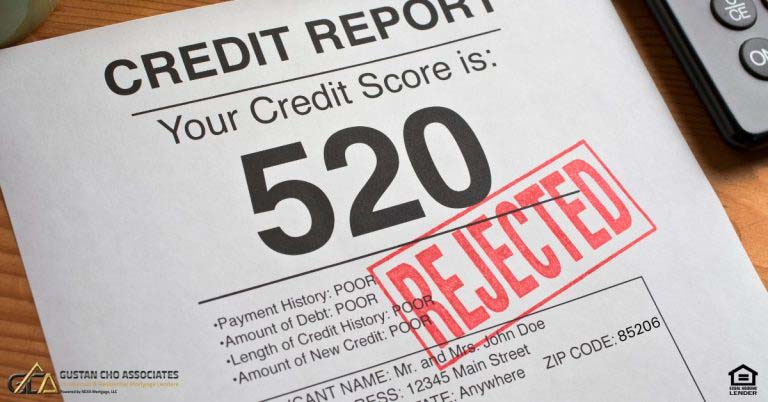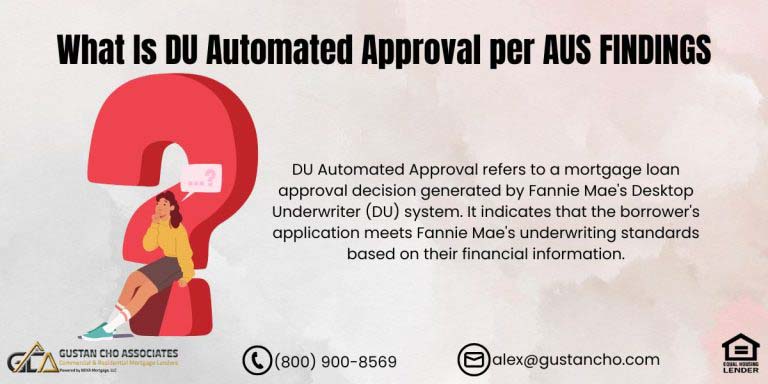HUD DTI Guidelines on Manual vs AUS Findings: What You Need to Know for 2024
When buying a home with an FHA loan, understanding your debt-to-income ratio (DTI) is crucial. Knowing how your DTI is assessed can make all the difference in getting approved if you are a first-time homebuyer or looking to refinance.
In this post, we’ll break down HUD’s DTI guidelines, compare manual underwriting with Automated Underwriting System (AUS) findings, and offer you tips to navigate the mortgage process in 2024.
What Is the Debt-to-Income Ratio (DTI)?
Lenders consider your debt-to-income ratio (DTI) as an important factor in determining your mortgage eligibility. Simply put, it’s the percentage of your monthly income that goes toward paying debts. These debts include credit cards, auto loans, student loans, and, of course, your future mortgage payment.
There are two types of DTI ratios:
- Front-end DTI: This represents the portion of your earnings allocated to your new mortgage payment, covering principal, interest, taxes, and insurance.
- Back-end DTI: This is the percentage of your income going toward all your monthly debts, including your new mortgage payment.
For FHA loans, HUD sets specific DTI guidelines that lenders must follow. However, how your DTI is assessed can vary depending on whether your loan is processed through manual or an Automated Underwriting System (AUS).
Confused About Manual vs. AUS Findings on FHA Loans? Let Us Guide You!
Contact us today to learn which method is right for your situation and how we can help you qualify.
FHA Loans: Why They’re a Top Choice for Borrowers with High DTI
If you’re considering a home loan but are worried about your credit score or how much debt you already have, FHA loans could be what you’re looking for. These loans are more forgiving regarding your credit history and how much debt you carry compared to other home loan types. This makes them super helpful for folks who might not have the squeaky-clean financial background needed for more traditional loans.
Now, diving into 2024, FHA loans are still a go-to for many potential homeowners who find other options out of reach. However, it’s important to know that only some FHA loans are the same. The journey your loan application goes through—either checked by an automated system (AUS) or reviewed by a real person (manual underwriting)—can make a big difference, especially when it comes to how much debt you can have.
This brings us to the HUD DTI guidelines on manual vs. AUS findings. These guidelines determine how much debt you can have compared to your income when applying for an FHA loan. Understanding these differences can help you evaluate your chances of getting a loan and prepare your application accordingly.
Understanding Automated Underwriting Systems (AUS)
An Automated Underwriting System (AUS) is a software application that assesses your mortgage request and offers an immediate verdict on your eligibility for a loan. The AUS considers various factors, including your credit score, income, employment history, and, importantly, your DTI ratio.
When you apply for an FHA loan, your lender will often use an AUS to determine your eligibility. If the system gives you an “approve/eligible” finding, you’re likely on the fast track to mortgage approval. However, if the AUS gives a “refer/eligible” finding, your loan may need to go through manual underwriting, where a human underwriter reviews your application in more detail.
HUD DTI Guidelines on AUS Findings
As of 2024, the maximum DTI ratios for FHA loans approved through AUS are as follows:
- Front-end DTI: 46.9%
- Back-end DTI: 56.9%
These limits are among the most generous in the mortgage industry, making FHA loans accessible to borrowers with higher debt loads. However, getting an AUS approval is more likely if you have a credit score of 620 or higher. If your credit score is below 620, the AUS might be less favorable, and your loan could be referred to manual underwriting.
HUD DTI Guidelines on Manual vs AUS Findings: What Happens if You Don’t Get AUS Approval?
If the AUS doesn’t give you an “approve/eligible” finding, don’t panic. It doesn’t mean you’re out of options—it just means your loan will need to be manually underwritten.
Manual Underwriting: When Human Review Matters
Manual underwriting comes into play when the AUS finds issues that require a more in-depth review. This could happen if you have a lower credit score, higher DTI, or complex financial circumstances. During manual underwriting, a human underwriter looks closely at your financial history and compensating factors to determine if you can handle a mortgage.
HUD DTI Guidelines on Manual Underwriting in 2024
In manual underwriting, the DTI limits are generally stricter than those for AUS-approved loans. Here’s what you can expect:
- Front-end DTI: Up to 40%
- Back-end DTI: Up to 50%
These limits can be exceeded if you have strong compensating factors, which we’ll discuss next.
What Are Compensating Factors?
Positive aspects of your financial profile, also known as compensating factors, can offset higher DTI ratios during manual underwriting. These factors can help convince the underwriter that you’re a good candidate for a mortgage, even if your DTI is higher than the recommended limits. Examples include:
- Strong Rental History: If you’ve been paying rent on time for the past 12 months, this shows that you can handle monthly housing payments.
- Large Down Payment: Putting more money down on your home can reduce the lender’s risk and improve your chances of approval.
- Significant Cash Reserves: Having extra savings in the bank reassures lenders that you can cover your mortgage payments in an emergency.
- Stable Employment: A long history with your employer or profession can demonstrate job stability.
If you have two or more compensating factors, you might be able to qualify for a manual underwrite with a DTI higher than the standard 40%/50% limits.
How to Improve Your Chances of Getting Approved
Whether your loan goes through AUS or manual underwriting, there are steps you can take to improve your chances of approval:
- Boost Your Credit Score: Aim to raise your credit score above 620 to increase your likelihood of getting an AUS “approve/eligible” finding.
- Reduce Your Debt: Pay down existing debts to lower your DTI ratio. Even small reductions can make a big difference.
- Save for a Larger Down Payment: The more you can put down, the better your chances of getting approved.
- Document All Income: Make sure all sources of income are documented and verifiable. This includes part-time work, bonuses, and other non-traditional income.
How Collection Accounts Affect Your DTI
FHA loans have a distinct approach to dealing with collection accounts. Medical collections and charge-offs are generally excluded from DTI calculations. However, if you have over $2,000 in non-medical collections, 5% of the outstanding balance will be included in your DTI ratio, even if you’re not required to make payments on those accounts.
Updated FHA Loan Requirements for 2024
The FHA has made some updates to its guidelines for 2024, making it even easier for borrowers with higher DTIs to qualify for a loan. Here are some key points to keep in mind:
- Minimum Credit Score: The lowest credit score accepted for a down payment of 3.5% is still 580. However, borrowers between 500 and 579 scores can qualify for a 10% down payment.
- Lender Overlays: Some lenders impose stricter requirements, known as overlays, on top of HUD’s guidelines. For instance, while HUD allows for a 580 credit score, some lenders may require a 620 score. It’s important to shop around and find a lender that follows HUD’s minimum requirements.
Not Sure Whether Manual Underwriting or AUS Findings Apply to Your FHA Loan? We Can Help!
Contact us today to find out how we can guide you through the process.
VA Loans and Manual Underwriting
Like FHA loans, VA loans allow manual underwriting. The guidelines are similar, but VA loans have no official minimum credit score, although lenders often impose their own overlays. Manual underwriting is typically reserved for borrowers who have had credit challenges but have demonstrated strong residual income and a good payment history over the past 12 months.
Conventional Loans vs. FHA Loans: DTI and Approval
If you’re considering a conventional loan, keep in mind that the DTI limits are generally stricter than those for FHA loans. Fannie Mae and Freddie Mac usually limit DTI ratios to 45%. Some flexibility of up to 50% is allowed for borrowers with higher credit scores.
Why FHA Loans Are Often the Better Choice
FHA loans are often the best option for borrowers with higher DTIs or lower credit scores. They offer more flexibility and lower down payment requirements, making homeownership accessible to more people. In 2024, FHA loans will remain a go-to choice for those looking to buy a home without perfect credit or a hefty down payment.
Seller Concessions and Lender Credits
One of the advantages of FHA loans is the ability to use seller concessions and lender credits to cover closing costs. Sellers can contribute a maximum of 6% of the home’s purchase price towards closing costs. These costs can encompass various expenses, such as taxes and insurance. Additionally, some lenders offer credits in exchange for a slightly higher interest rate, helping you reduce your out-of-pocket expenses at closing.
Gift Funds for Down Payment
Another benefit of FHA loans is the ability to use gift funds for your down payment. As long as the gift comes from a family member or close friend, you can use it to cover all or part of your down payment. Just be sure to document the gift properly, as your lender will require proof that it’s a true gift, not a loan.
Conclusion: Navigating HUD DTI Guidelines in 2024
Understanding HUD’s DTI guidelines and how they differ between manual underwriting and AUS findings is crucial for securing an FHA loan in 2024. For a first-time homebuyer or if you’re considering refinancing, understanding these principles can boost your likelihood of approval.
Don’t be discouraged if you have high DTI ratios or lower credit scores. FHA loans offer more flexibility than most other loan programs. With the right strategy, you can overcome the challenges of higher DTI.
Prepare well for a successful mortgage application by improving your credit, reducing debt, saving more for a down payment, and documenting all your income. These steps will place you on the path to homeownership by 2024.
Contact us today for more personalized advice or to start your FHA loan application. We’re here to help you navigate the mortgage process and achieve your homeownership dreams.
FAQs: HUD DTI Guidelines on Manual vs AUS Findings on FHA Loans
- 1. What is the debt-to-income ratio (DTI)? The debt-to-income ratio (DTI) represents the portion of your monthly income allocated to debt repayment. Lenders use this ratio to evaluate your capacity to handle monthly financial obligations and to ascertain your eligibility for a mortgage.
- 2. How does HUD set DTI guidelines for FHA loans? HUD sets specific DTI limits for FHA loans. These guidelines vary depending on whether your loan is processed through an Automated Underwriting System (AUS) or manual underwriting.
- 3. What are the maximum DTI limits for FHA loans in 2024? For loans approved through AUS, the maximum front-end DTI is 46.9%, and the back-end DTI is 56.9%. For manual underwriting, the limits are generally lower, with a front-end DTI of up to 40% and a back-end DTI of up to 50%.
- 4. What happens if my loan doesn’t get approved through AUS? Suppose your loan doesn’t get an “approve/eligible” finding through AUS. In that case, it may go through manual underwriting, where a human underwriter will review your financial situation in more detail.
- 5. What are compensating factors, and how do they affect manual underwriting? Compensating factors are positive aspects of your financial profile, like a strong rental history or large down payment, that can offset a higher DTI ratio during manual underwriting.
- 6. Can I still get an FHA loan with a high DTI ratio? FHA loans are more flexible with DTI ratios than other loan types. However, if your DTI is high, having compensating factors can improve your chances of approval.
- 7. Does my credit score affect my chances of getting approved through AUS? A credit score of 620 or higher increases your chances of getting an “approve/eligible” finding through AUS. If your score is below 620, your loan may need to go through manual underwriting.
- 8. How do collection accounts impact my DTI calculation? Medical collections and charge-offs are usually excluded from DTI calculations for FHA loans. However, if you have over $2,000 in non-medical collections, 5% of that balance will be factored into your DTI.
- 9. What is the difference between manual underwriting and AUS? AUS is a computerized system that quickly determines your loan eligibility based on your financial data. Manual underwriting involves a human underwriter reviewing your financial details more closely, and it is often required if the AUS doesn’t approve your loan.
- 10. Why should I consider an FHA loan if I have a high DTI or low credit score? The purpose of FHA loans is to make it easier for borrowers with higher DTI ratios or lower credit scores to access them. They have more flexible guidelines, meaning more people can become homeowners.
If you have any questions about HUD DTI Guidelines on Manual vs AUS Findings, please contact us at 800-900-8569. Text us for a faster response. Or email us at alex@gustancho.com. The team at Gustan Cho Associates is available 7 days a week, on evenings, weekends, and holidays.
This blog about HUD DTI Guidelines on Manual vs AUS Findings on FHA Loans was updated on August 28th, 2024.
Manual Underwriting or AUS Findings: Which Is Best for Your FHA Loan? Let’s Find Out!
Reach out now for expert advice on how manual vs. AUS findings apply to your situation.











Exactly the information I was looking for.
Current lender advised our dti is not ratioing. When per your post our ratios are fine.
Lisa,
Most mortgage lenders have mortgage lender overlays where they may cap debt to income ratios at 43% DTI, 45% DTI, or 50% DTI even though FHA states that the maximum debt to income ratios allowed on FHA borrowers is 56.9% DTI as long as your credit scores are at least 620 FICO credit scores. This is called a FHA mortgage lender overlay on behalf of the mortgage lender. If you are dealing with a lender with overlays on debt to income ratios, no need to worry because I can help you. Please call me at 800 900 8569 or email me at gcho@gustancho.com and I can help you. I have no lender overlays.